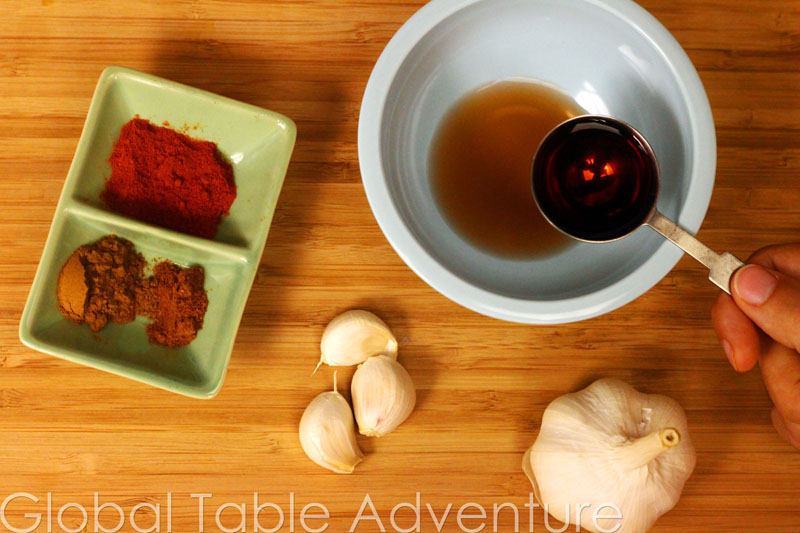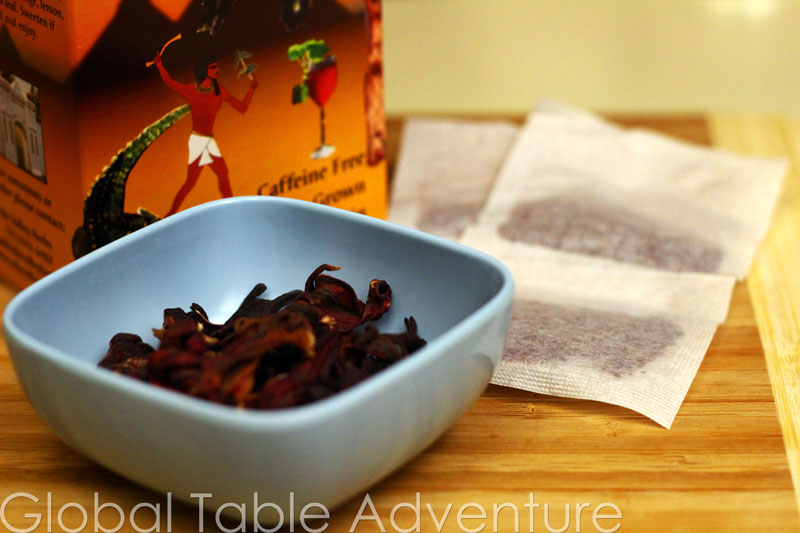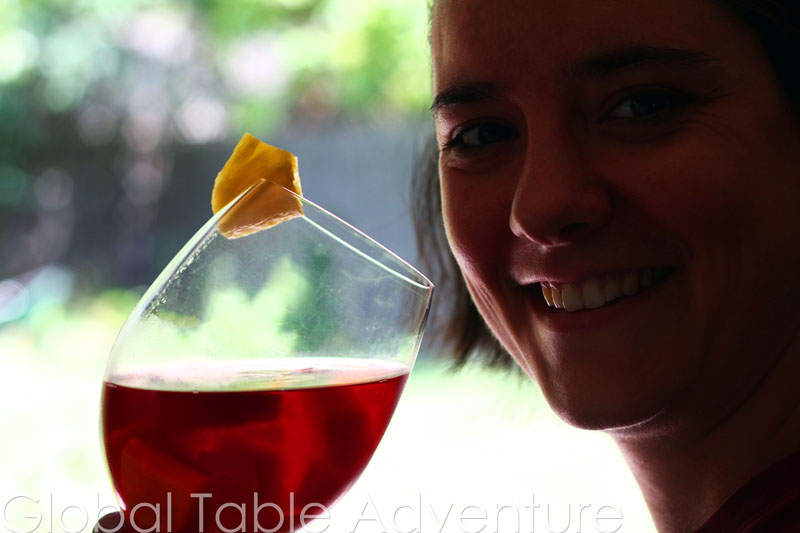“The smell is making my eyes water. One bite, and I can’t get the flavor out of my mouth! It’s like I’m still eating it. That counts, right?” Keith looked at me with his best puppy dog eyes. And, since his eyes are hazel, he didn’t look much like a puppy. “Just eat half of it,” I said. “I can’t,” he replied, turning his plate so the Babenda was as far away as possible. I kept eating, thinking about how fishy the Babenda tasted. Maybe he would eat some more of the unusual West African dish if I hadn’t tossed in so many dried anchovies. Or if he hadn’t seen me put them in. Maybe, just maybe, if we had some adventurous friends over, he might succumb to peer pressure and eat just a little more. I took a big bite and then gave Ava some. “Your loss!” Ignoring me, he picked up another lamb skewer, buried it in a blizzard of Kan Kan Kan and took a bite. “Now these are good!” he grinned. Sigh. This …
Read More
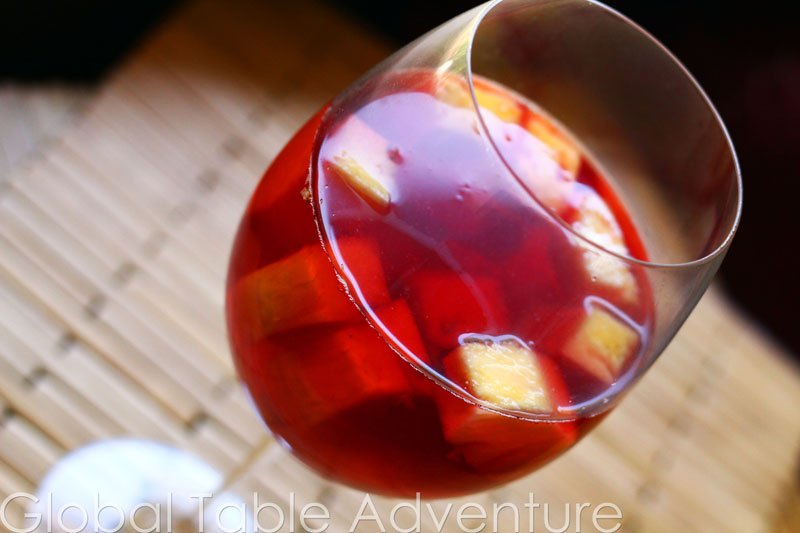
Makes 1.75 liters (plus the pineapple) Chilled hibiscus tea is light and refreshing. The natural floral tang is a wonderful counterpart to sweet pineapple chunks. Kids will love fishing out the fruit in this totally and wonderfully decaffeinated iced tea. VARIATION: Some recipes call for equal parts lemonade to hibiscus tea. We tried this “pink lemonade” and loved it! Ingredients: small handful hibiscus flowers (or 4 teabags) 6 cups boiling water 4 cups ice 1 pineapple, cubed Method: 1. Pour boiling water over hibiscus flowers or teabags. Let steep about 30 minutes. Hibiscus puts on a wonderful show as the purplish dried leaves turn the water vivid red. Strain into ice to speed up cooling. Trust me, you won’t want to wait any longer than you have to! Serve chilled with chunks of pineapple. I made my chunks large. I couldn’t help it. This was the sweetest pineapple I’ve had in a long time. Yum! Cheers! I hope you the last bit of your summer is splendid! Iced Hibiscus Drink with Fresh Pineapple | Bissap …
Read More
Serves 4 Borasheht (or brochettes/kabobs) can be any sort of skewered meat. In our recipe, tender pieces of lamb are marinated in a spicy sauce. As you bite into the lamb, your mouth fills with a hint of cinnamon and garlic, mild tang from the vinegar, and a steady, creeping burn from the cayenne (about mild, on my scale). NOTE: If you would like some extra heat on the side, try our Kan Kan Kan spice blend, popular in Burkina Faso. Ingredients: 1/2 tsp paprika 1/2 tsp cinnamon 1/4 tsp cayenne 3 cloves garlic, crushed salt, to taste 2 Tbsp vinegar 1 1/2 lbs lamb meat, cubed for skewers Method: 1. In a small bowl, mix together paprika, cinnamon, cayenne, garlic, salt, and vinegar. Have I told you recently how much I adore garlic? Salt not only adds flavor, but tenderizes the meat as well. Give everything a quick stir. No power equipment needed here! 2. Rub marinade all over the lamb pieces. Refrigerate overnight, or for at least 3 hours. Keith snuck this photo …
Read More
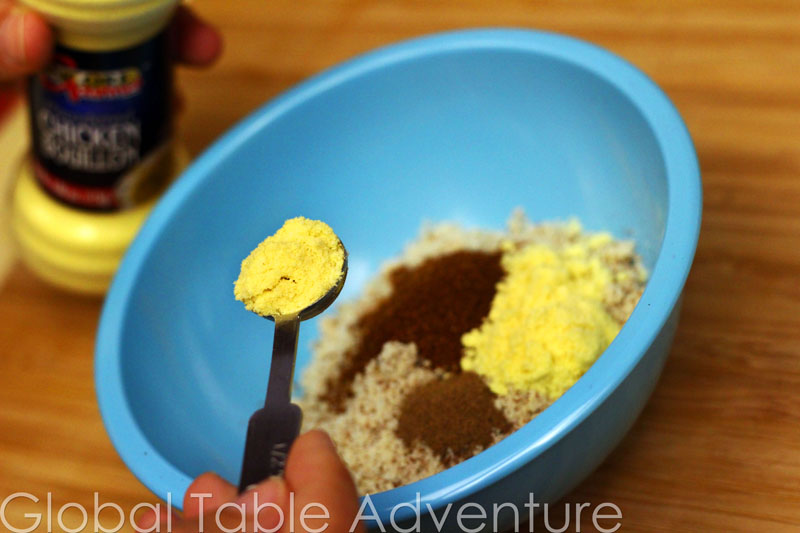
Makes about 1/2 cup This is my own version of the jarred Kan Kan Kan spice blend popular in Burkina Faso. The raw peanut powder offers a slight grassy flavor, dominated by heat from the chili powder and saltiness from the bouillon. Try with our Grilled Lamb Brochettes. While the jarred stuff alleges to be an aphrodisiac, I happened upon the description of this spice blend on an expat blog which – unfortunately -I can no longer track down. I mixed it together to taste. If you want the aphrodisiac, you’ll want to add a lot more ingredients, like ginger, mustard seed, and cinnamon. NOTE: Peanut powder and Maggi cubes can be found at African markets. I went to Tulsa’s local Tropical market. Ingredients: 1/2 cup peanut powder 1 tsp chili powder 1/4 tsp allspice 2 Maggi bouillon cubes or 2 tsp powdered bouillon Method: Take all ingredients and mix together in a small bowl. If you use maggi cubes, crush them with the back of the spoon. If, like me, you accidentally buy SHRIMP flavored …
Read More
The making of a Christmas Feast in Burkina Faso. Part One: Shows the preparation of the meal on the outdoor fires. Part Two: The finished dishes are presented to the camera.
Read More
Happy Friday! I’m craving a giant slice of chocolate cake. But enough about me, let’s talk about Burkina Faso! Most meals in the villages are shared out of a single pot (true family style) and the right hand is used to scoop up the food. The cities eat European style – fork, knife, spoon, plate. Frog and toad meat is eaten “dried or fried” in Burkina Faso, with hundreds of frogs laid out to dry in the hot African sun (Photographs are available to view on National Geographic, Fried or dried, frogs are popular food in African Markets) Part of the country was colonized by France, therefore many French foods and techniques have made their way into Burkinabe tradition, such as the ubiquitous green bean. Bissap, Roselle, sorrel, and Hibiscus are all names for the plant leaves that flavor Bissap Tea, high in vitamin C and believed to help reduce cholesterol
Read More
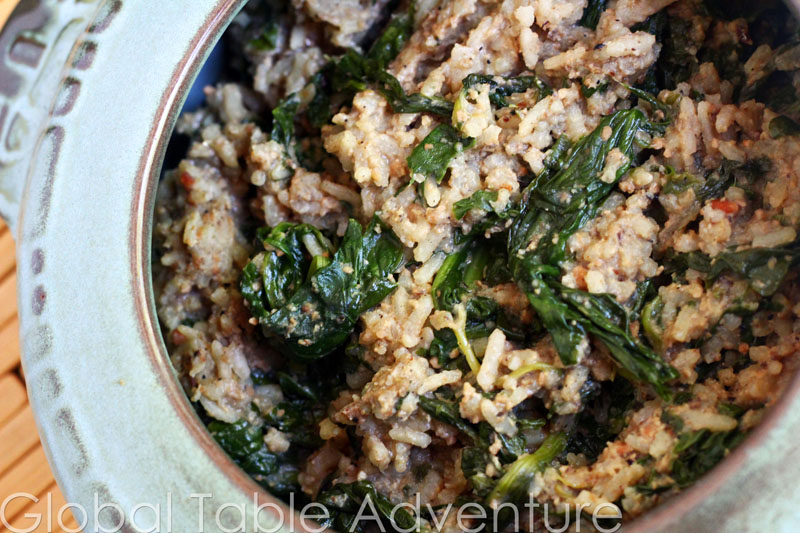
If you enjoy the flavor of funky blue cheese, dried or smoked fish, and bitter greens, then Babenda is for you! I know. I’m asking a lot. Although we might be a select group of people with such accommodating palates, this one pot meal is a common staple in Burkina Faso. Babenda is like a jazz orchestra in the mouth, making wild taste sensations and pungent high notes meander whimsically through mouth and home. Ingredient Overview: The Greens: Any bitter greens can be used for Babenda, including spinach, kale, swiss chard, or mustard greens. Of these, swiss chard is the mildest. If you use a more intensely bitter green (like kale), Burkinabe traditionally add a dash of potash (or baking soda) to mellow the flavor out. Soumbala: Soumbala (also called dawadawa) is fermented locust bean. I found it frozen at a Tropical market in Tulsa. The dark brown bean smells like a sharp blue cheese and, just like blue cheese, will make your mouth tingle. Dried Fish: Dried fish are readily available in Burkina Faso, including sardines …
Read More
One day of 100+ degree weather is bad enough. My thermostat showed 105 twice in the last three days. Heck, it was 100F before noon yesterday! This is a summer heat blizzard of epic proportions. The worst part? You can’t shovel it away. In light of our heat wave, I put together a Burkinabe menu that can be made without much indoor heat. The kabobs are perfect for the grill, the Kan Kan Kan requires no cooking (hurrah), and the hibiscus tea is steeped in a bit of boiling water and then chilled with ice. The only exception is Babenda, which gets cooked on the stovetop, but this dish was simply too interesting to pass up. Come to think of it, if you have a burner on your grill, you can probably make the Babenda outside, too. Wonderful! Spiced Lamb Kabobs (Broasheht) [Recipe] Lamb marinated in a tangy spice rub made with cinnamon, paprika, cayenne pepper, and vinegar. Spiced Peanut Powder (Kan Kan Kan) [Recipe] Sprinkle this alleged aphrodisiac over any grilled meat. Made with …
Read More

Burkina Faso is a dizzying landscape of dusty red plains and grassy savannas, broken up by stunning rock formations that tower above the ground. The culinary landscape of Burkina Faso is similar – plain, sparse even – with the occasional burst of unexpected flavor. Let me explain. Most meals are centered around pieces of Tô, a firm ball of white starch made with millet, sorghum, or corn. These bland balls are wonderfully adaptive because they take on the flavor the broths, soups, and stews that they are dipped into, often tomato or peanut based. This is every day fare – the turkey sandwich of Burkina Faso. And, just like our sandwiches, Tô is eaten by hand. This simple meal routine is broken up with rice, cous cous, or even maize. Here’s where the burst of unexpected flavor comes in. A blend of bitter greens, such as spinach, kale, or even mild cabbage, can be cooked with the grains to make a complete dish called Babenda (recipe). What makes Babenda interesting are the fermented locust beans (called …
Read More
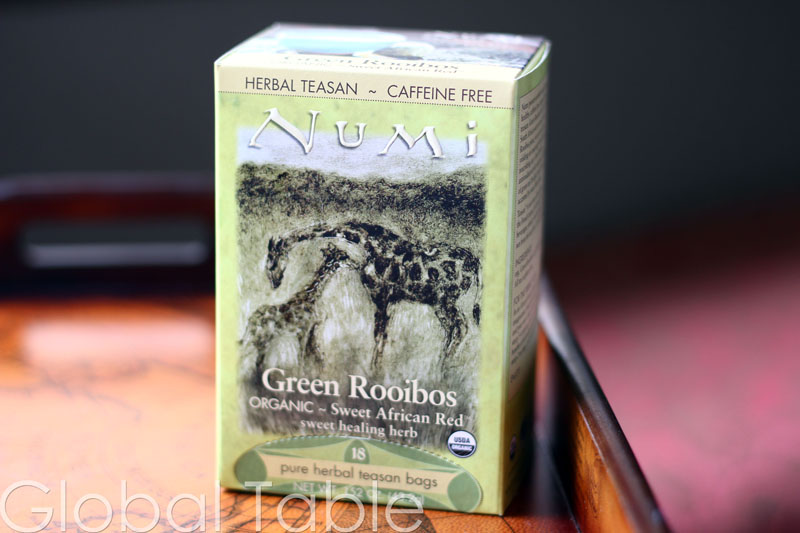
With a few simple steps, our Botswana Global Table Adventure transformed minimal ingredients into a tasty feast. Although I struggled to get Keith to eat the spinach (spoiler: I won), the general consensus was that this was a great meal, worthy of any weeknight menu. Stewed Beef (Seswaa) [Recipe] What I liked most about this dish: I made Seswaa with a beautiful, fatty piece of chuck. As the marbling broke down, the stew’s flavor grew deeper and richer. I was amazed at how much meaty deliciousness came through this simple dish. I found myself smacking my lips and wanting more. Looking around, seemed like the family was in agreement. Since making Seswaa, I’ve been dreaming of ladling the meaty gravy over freshly baked biscuits. Oh man, that would be good. What I liked least about this dish: I know Seswaa isn’t much to look at, but the stew is just so tasty. Since there are few ingredients, Seswaa’s flavor depends on the cut of meat you get. Ideally, choose a fresh piece of well-marbled meat. …
Read More
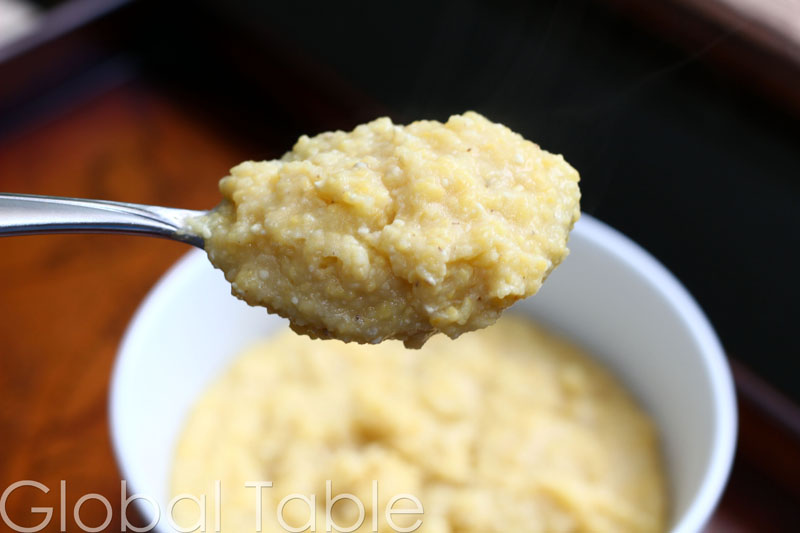
Serves 2-4 In Botswana, Cornmeal Pap is eaten with the fingers, dipped into stews to pick up additional flavor. Like soft polenta, Cornmeal Pap goes well with any stewed meat or vegetable. The mixture stiffens up quickly, however, so serve immediately after cooking. NOTE: Please use white cornmeal for authentic pap. (I had to substitute yellow) Ingredients: 1 cup cornmeal (fine or medium grind is best) 1 quart broth (vegetable, chicken, or beef) salt pepper Method: 1. In a medium pot, bring stock to a boil. 2. Stream in cornmeal slowly. Whisk continually to keep mixture from lumping. 3. As mixture thickens, you may need to switch to a wooden spoon. Allow to simmer gently until cooked to desired consistency, about 20 minutes. Season with salt and pepper. Serve immediately (Pap stiffens up considerably as it cools). Cornmeal Pap Votes: 0 Rating: 0 You: Rate this recipe! Print Recipe In Botswana, Cornmeal Pap is eaten with the fingers, dipped into stews to pick up additional flavor. Like soft polenta, Cornmeal Pap goes well with any stewed …
Read More

Serves 2-4 Seswaa is traditionally highly salted. In fact, the simplest renditions of this yummy dish are made with nothing more than beef, salt, and water. Our version includes onion and minimal salt, since I was serving it to my daughter. The thickened juices become rich from long, slow simmering. Something between gravy and pulled pork in texture, this dish would be wonderful poured over biscuits. Ingredients: 1 1/2 lbs beef, cubed (I used chuck) 1 large onion, chopped water 2-4 Tbsp flour salt pepper Method: 1. Place all ingredients in a medium pot, except flour. The water should just cover the top of the beef. Bring to a simmer and cook uncovered for 2 hours. NOTE: Skim the fat every 20 minutes or so for a lighter flavor. 2. Using an immersion blender (or a mallet) break up some of the meat into small pieces. 3. Make a flour slurry (mix a little water with flour until it forms a glue-like consistency). Add to stew. Cook a few additional minutes, until the flour thickens …
Read More

